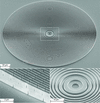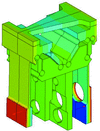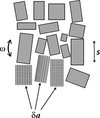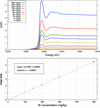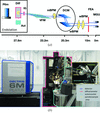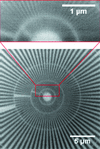issue contents
May 2014 issue

Cover illustration: An example of a three-level nickel zone plate with 200 µm diameter and effective 200 nm smallest zone width (see Mohacsi, Karvinen, Vartiainen, Guzenko, Somogyi, Kewish, Mercere and David, pages 497-501). The marked regions are shown below with higher magnification, showing the individual steps of 2/3 and 1/3 fill factor at the centre and at the edge of the zone plate. The effective smallest zone width is the half-period of 200 nm.
facility information
research papers
Circularly polarized X-ray free-electron laser beams have been generated at 11.56 keV, using a diamond crystal phase retarder at SACLA.
The collimating L-shaped laterally graded multilayer mirror is a vital part of the ultrahigh-resolution inelastic X-ray scattering spectrometer at NSLS-II. This article presents numerical evaluation and experimental characterization of the mirror performance as well as the technical requirements of its operation.
Open  access
access
 access
accessA bent Laue beam-expanding double-crystal monochromator was developed and tested at the Biomedical Imaging and Therapy beamline at the Canadian Light Source. The expander will reduce scanning time for micro-computed tomography and allow dynamic imaging that has not previously been possible at this beamline.
A new method of harmonics suppression based on X-ray refractive optics has been proposed and attenuation of higher-orders harmonics to five orders of magnitude using the monochromator detuning was achieved.
Simulated beam sizes and image distances of the toroidal focusing mirror as a function of the grazing incident angle are presented.
Open  access
access
 access
accessMultilevel zone plates have been successfully combined with zone-plate stacking to achieve both high-resolution and high-efficiency nanofocusing at 6.5 keV photon energy.
In order to improve the efficiency of X-ray absorption data recording, a fast scan method, the Turboscan, has been developed on the DEIMOS beamline at Synchrotron SOLEIL, consisting of a software-synchronized continuous motion of the monochromator and undulator motors. This process suppresses the time loss when waiting for the motors to reach their target positions, as well as software dead-time, while preserving excellent beam characteristics.
Open  access
access
 access
accessAnisotropic elasticity of single-crystal silicon, applications to modelling of a bent X-ray mirror, and thermal deformation of a liquid-nitrogen-cooled monochromator crystal are presented.
Benchmarking and validation of a new Monte Carlo code for dose calculations in microbeam radiation therapy are described.
An in-vacuum PILATUS 1M detector that covers a photon energy range from 10 keV down to 1.75 keV is characterized in terms of radiometric and geometric properties with low uncertainties. Benefits of photon energies below 5 keV are demonstrated by grazing-incidence small-angle X-ray scattering measurements.
Open  access
access
 access
accessExpressions are given to match X-ray data collection facilities to the intrinsic diffraction properties of crystals with different degrees of perfection.
A novel scattering technique in reflection geometry which enables a topological description of very rough surfaces of disordered systems is presented. The set-up uses soft X-rays at wide incident angles.
Open  access
access
 access
accessA successful application of singular value decomposition analysis to time-dependent powder diffraction data of an in-situ photodimerization reaction of some anthracene derivatives is presented.
A novel method is proposed for the correction of self-absorption effects of extended X-ray absorption fine structure measured in the fluorescence mode on single-layer or multilayer samples. The validity of this method is verified by good agreements on the corrected spectra of a Cr/C multilayer measured at different experimental geometries.
A method for unsupervised identification of biological cells in X-ray fluorescence microscopy data is described, allowing us to obtain distributions for elemental content by cell type without manual labeling.
Synchrotron far-infrared spectroscopy of corroded steel surfaces using a variable angle of incidence
The analysis of thin films and corrosion products by synchrotron far-infrared spectroscopy has shown that using a range of incidence angles leads to improved identification of the spectral features. The effect of the incidence angle on the band intensity in the infrared spectra is described with respect to the surface roughness.
Open  access
access
 access
accessA quantitative local computed tomography combined with data-constrained modelling has been developed. The method could improve distinctly the spatial resolution and the composition resolution in a sample larger than the field of view, for quantitative characterization of three-dimensional distributions of material compositions and void.
The recent development of instrumentation for coherent diffraction imaging with hard X-rays is presented. The three-dimensional structure of a cluster made of randomly assembled Fe2P nanorods has been revealed using coherent 8 keV X-rays.
Open  access
access
 access
accessThe software suite SITENNO is developed for processing diffraction data collected in coherent X-ray diffraction imaging experiments of non-crystalline particles using an X-ray free-electron laser.
Open  access
access
 access
accessA framework combining wave-optics with Monte Carlo methods for numerical simulations of phase-sensitive X-ray imaging has been developed.
short communications
A method of quantifying absorber concentration from XANES spectra while correcting for effects of variable sample thickness is described.
beamlines
Open  access
access
 access
accessA description of the upgraded beamline X25 at the NSLS, operated by the PXRR and the Photon Sciences Directorate serving the Macromolecular Crystallography community, is presented.
The Canadian Macromolecular Crystallography Facility beamline 08B1-1, an automated and remotely accessible beamline at the Canadian Light Source, is reported. Scientific highlights are also presented.
letters to the editor
Free 

Owing to its success in promoting connections between users and facilities, the European Synchrotron User Organization champions the continuation of transnational access to national radiation sources in the European research area.
addenda and errata
Free 

Corrections to the article by Mayer et al. [J. Synchrotron Rad. (2013), 20, 433–440] are given.
current events
Free 



 journal menu
journal menu






















